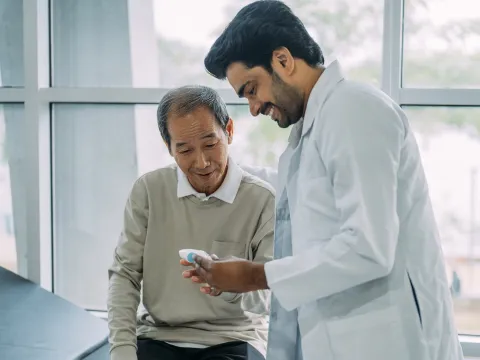- AdventHealth

Choose the health content that’s right for you, and get it delivered right in your inbox.
Skin cancer is the most common cancer in the U.S. It’s also the most preventable. Wearing sunscreen protects your whole health by reducing your risk of getting skin cancer, preventing sunburn and helping prevent early signs of skin aging. That’s why it’s important to make it a regular part of your skincare routine.
According to the American Academy of Dermatology, using a broad-spectrum sunscreen with SPF 30 or higher can:
- Reduce your risk of developing skin cancer
- Prevent sunburn
- Decrease signs of aging on your skin
We’re here to help you learn about different types of sunscreen, physical and chemical, and how they can help protect your skin from overexposure when you’re out enjoying the sun’s rays.
Physical Sunscreen
Physical sunscreens, more commonly known as mineral sunscreens, work by creating a physical barrier on the skin that shields it from the sun. You can think of physical sunscreen as a shield.
These sunscreens deliver broad-spectrum protection by reflecting radiation away from your skin. They also help ward off UVA-related skin damage, including dark patches and wrinkles.
Physical sunscreens can also help block UVA rays that come through windows, which can cause pigmentation and breakdown of collagen. That’s why it’s important to wear sunscreen every day, even if you’re not going outside.
Most mineral sunscreens are formulated with zinc oxide and titanium oxide, which are recognized as safe and effective by the Food and Drug Administration (FDA). Zinc oxide sunscreens are good for children and people with sensitive skin. They also offer the most broad-spectrum protection.
The only downside is that they can be difficult to spread and leave your skin looking white, but those outweigh the protective health benefits you’ll receive. Be sure to reapply as needed because physical sunscreens aren’t always water-resistant.
Chemical Sunscreen
Think of chemical sunscreens like sponges. They don’t sit on the skin or block rays. Instead, they feature active ingredients that absorb UV rays before your skin can soak them up. These chemical UV filters include:
- Avobenzone
- Homosalate
- Octinoxate
- Octisalate
- Octocrylene
- Oxybenzone
In most cases, chemical sunscreens don’t leave a visible film layer on the skin, which makes them easier to wear on a broader range of skin tones.
Most people prefer chemical sunscreens, simply because they’re easier to apply and wear. Chemical sunscreens are designed for absorption, so they tend to go on smoothly without feeling sticky or greasy, and they don’t leave the telltale white cast like physical sunscreen does.
Certain ingredients used in some chemical sunscreens are under review by the FDA: ensulizole, octisalate, homosalate, octocrylene, octinoxate, oxybenzone and avobenzone. Even with the additional research into chemical sunscreens, the FDA states:
"Given the recognized public health benefits of sunscreen use, Americans should continue to use sunscreen and other sun protective measures as this important rule-making effort moves forward."
Which Kind Should You Use?
Experts don’t advise that you skip sunscreen, but that you use discretion about which kind since the ingredients in chemical sunscreen may cause health risks related to endocrine functions, as well as cause skin reactions or exacerbate skin conditions like rosacea. If you have sensitive skin or allergies, opt for the physical sunscreens.
Children may also do better with physical sunscreens since they’re gentler on the skin. Chemical sunscreen has benefits like easier absorption and convenience. Both kinds will protect your skin from sun-related damage.
We’re here to support your whole health in body, mind and spirit. Your skin is the largest organ in your body and we want to help you keep its healthy glow for life. Contact your doctor to learn more.




